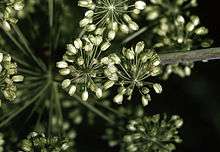Angelica atropurpurea
Angelica atropurpurea, known commonly as purplestem angelica, great angelica, American angelica, high angelica, and masterwort,[3] is a species of flowering plant that can be found in moist and swampy woodlands, mostly by riverbanks, in eastern North America. It has been found in eastern Canada (Nunavut, Ontario, Quebec, Labrador, Newfoundland, all 3 Maritime Provinces) and the United States (from New England south as far as North Carolina, and west to Minnesota, Iowa, and Tennessee).[4]
| Angelica atropurpurea | |
|---|---|
 | |
| Scientific classification | |
| Kingdom: | Plantae |
| Clade: | Tracheophytes |
| Clade: | Angiosperms |
| Clade: | Eudicots |
| Clade: | Asterids |
| Order: | Apiales |
| Family: | Apiaceae |
| Genus: | Angelica |
| Species: | A. atropurpurea |
| Binomial name | |
| Angelica atropurpurea | |
| Synonyms[2] | |
| |
The plant grows to 6 feet (180 cm) tall. The erect, branching stem is purple, smooth, hollow, and sturdy. The leaves are divided into segments. The total width of a lower leaf may be up to 2 feet (60 cm). The plant has white to greenish flowers in umbrella-like umbels. One umbel may have as many as 40 branches and be up to 8 inches (20 cm) across. The stalks can be eaten like celery and the flavor is similar. Early American settlers boiled parts of the plant to make into candy and added it to cakes. In Europe, it was believed that the plant could cure alcoholism.[5]
The aromatic root of angelica has widespread use as a purification herb among the Native American cultures. In California, it is often burned during a shaman's prayers in a healing ceremony.[6]
Angelica atropurpurea was held in high esteem by Indians in Arkansas, who always carried it in their medicine bags and mixed it with tobacco for smoking.[7]
In the Mvskoke Creek tribes of Alabama, Oklahoma, and Northwest Florida, Angelica atropurpurea (known as "Notossv" in the Creek language) has both medicinal and ceremonial uses. [8]
Medicinally, Notossv is used by the Creeks to: cure back pain in adults; to calm panic attacks or people that are in hysterics; as a vermifuge in children; as well as treating stomach disorders. [8]
Mvskoke Creek Ceremonial uses include preventing heat stroke during the Ribbon Dance in the Green Corn Ceremony, aiding ceremonial singers, and to help those in legal trouble. [8]
References
- Maiz-Tome, L. (2013). "Angelica atropurpurea". The IUCN Red List of Threatened Species. IUCN. 208. e.T64263861A67728523. doi:10.2305/IUCN.UK.2016-1.RLTS.T64263861A67728523.en.
- The Plant List, Angelica atropurpurea L.
- Purplestem Angelica. The Center for New Crops & Plant Products. Purdue University.
- Biota of North America Program 2014 state-level distribution map
- Runkel, S. T. and A. F. Bull. Wildflowers of Iowa Woodlands. 1979. page 139.
- Lyon, William S. (1998). Encyclopedia of Native American Healing. W.W. Norton & Company, Inc. p. 16. ISBN 0-393-31735-8.
- Vogel, Virgil J. (1990). American Indian Medicine. University of Oklahoma Press. p. 272.
- Lewis, David (2002). Creek Indian Medicine Ways. University of New Mexico Press. p. 155.
